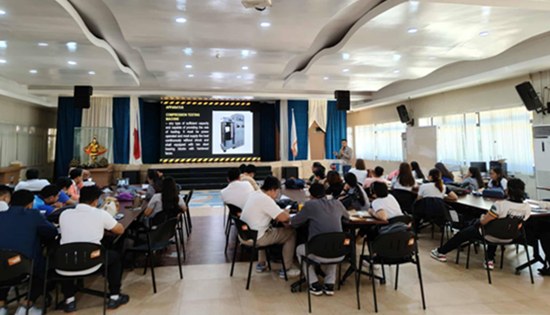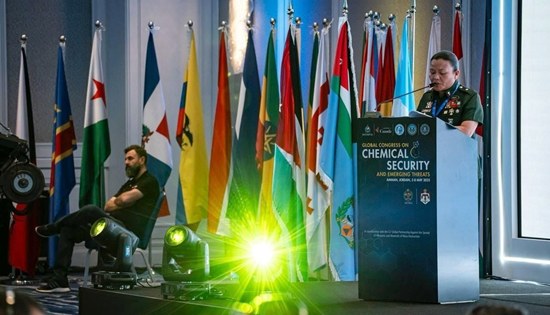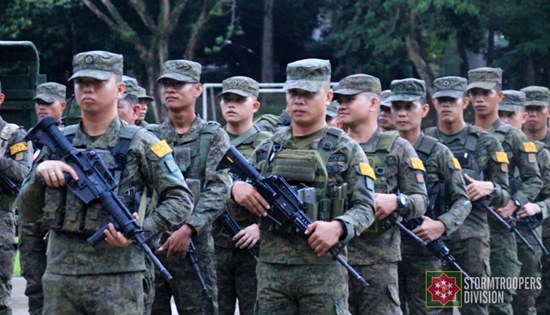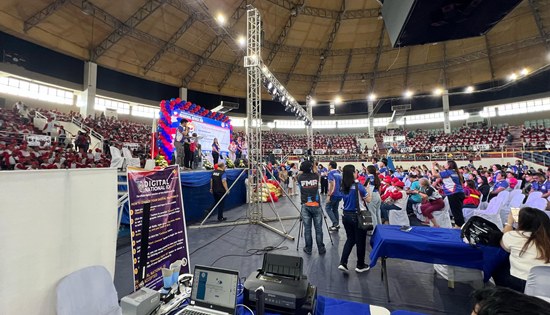Engr. Pancito serves as
resource speaker in Materials Testing Technology 2025

PRESS RELEASE
May 16, 2025
CATBALOGAN CITY –
Engr. Alan P. Pancito, Jr., Head of the Quality Implementation Unit
under the Quality Assurance Section, was officially appointed by the
Regional Director of the Regional Office to serve as one of the
in-house resource speakers for the Materials Testing Technology 2025
training on May 13, 2025. His appointment reflects the Regional
Office’s recognition of his technical expertise, leadership, and
commitment to promoting quality assurance in infrastructure
development.
Among the various District
Engineering Offices of DPWH Region VIII, Engr. Pancito was one of
only two representatives selected as resource speakers, with the
rest coming exclusively from the Regional Office. As part of his
role, Engr. Pancito was assigned to deliver lectures and provide
in-depth technical discussions on Concrete, focusing on both Paving
and Structural Concrete. His session aimed to enhance the knowledge
and competencies of field engineers and laboratory personnel,
ensuring that they are updated with current standards, practices,
and innovations in materials testing and quality control.
During the session, Engr.
Pancito presented key concepts including the selection of materials,
mix proportioning, workability, durability, field implementation
strategies, procedures of molding, curing, testing of the samples
and presenting the alternative way of acceptance of concrete. He
also shared practical experiences, which enriched the learning of
the participants and encouraged engagement and discussion.
His participation made a
substantial contribution to the success of the Materials Testing
Technology 2025 program, particularly in advancing the goals of
consistency, accuracy, and integrity in materials testing throughout
the region.
NAMFREL releases
preliminary assessment of the 2025 National and Local Elections
By
NAMFREL
May 16, 2025
QUEZON CITY –
NAMFREL wishes to congratulate the Filipino people for again turning
out in droves to vote on election day and making their voices heard
through their votes. NAMFREL also expresses its deep appreciation
for all its Bantay ng Bayan volunteers nationwide for following all
processes of election day and helping ensure that Philippine
elections are free, fair, and transparent.
As NAMFREL continues to
receive observations from its volunteers deployed nationwide,
NAMFREL is able to see a clearer picture of the conduct of election
day processes.
NAMFREL reiterates its
initial assessment on election morning that in general, the 2025
national and local elections were peaceful and orderly. However,
NAMFREL has also noted that in some parts of the country, election
day was marred by violence and other public disturbances that caused
disruption and delay in the conduct of election day processes in
said areas. Election day also saw issues related to the automated
counting machines (ACMs), and to physical arrangements in voting
centers usually expected because of high voter turnouts, that
brought about inconvenience to many voters.
Violence and other
disturbances to peace and order
NAMFREL condemns the
incidents of violence reported and verified by NAMFREL observers
that took place in several municipalities of Lanao del Sur, as well
as in SIlay, Negros Occidental and in Datu Odin Sinsuat, Maguindanao
del Norte. NAMFREL is also following other incidents reported in the
media but have not been verified by our volunteers. Violence has no
place in a democratic society. NAMFREL encourages authorities to
thoroughly investigate these incidents and bring the perpetrators to
justice.
NAMFREL is part of the
Independent Election Monitoring Center (IEMC) for BARMM and Sulu, a
collaborative initiative led by several organizations including
NAMFREL, the Institute for Autonomy and Governance (IAG), Notre Dame
University (NDU), Notre Dame Broadcasting Corporation (NDBC),
Climate Conflict Action, Coalition for Social Accountability and
Transparency (CSAT), and PPCRV Cotabato City. Based in NDU in
Cotabato City, the IEMC aims to uphold electoral integrity by
tracking election-related incidents, conducting real-time results
reporting, and facilitating engagement with stakeholders such as
COMELEC, security agencies, and the media. The IEMC has been
releasing reports since before election day. The Center will further
intensify its partnerships and activities as the Bangsamoro region
gets closer to the 2025 BARMM Parliamentary Elections scheduled for
October.
Automated counting
machines (ACMs)
NAMFREL continues to
receive election day reports about the automated counting machines (ACMs)
not performing as expected, observed in a number of polling places
across the country. NAMFREL observers, however, have emphasized that
most of the reported incidents involving the ACMs were immediately
resolved. Some of the most common observations related ACMs were the
following:
• Ballots not being
accepted because scanners were not clean; ACM lens needed to be
wiped, which took up to 20 minutes in some cases
• Ballots not being
accepted at first try, but fixed by re-inserting the ballots
• Ballot paper jam due to
ballot tear or crease
• Voter-verified paper
audit trail paper jam
• ACMs slowing down,
attributed to overheating
There were reports of
voters complaining that their VVPAT indicated an overvote for a
position and thus invalidating the vote, while voter insisted that
they did not overvote..
Polling place and voting
center woes
Apart from issues
concerning ACMs, a common observation made by NAMFREL observers
inside polling places was the lack of vote secrecy, some due to
members of the electoral boards (EBs) inserting the filled out
ballots instead of the voters. There was also a lack of ballot
secrecy folders according to observers, or voters unable to fill out
their ballots immediately because people lining up to insert their
ballots in the ACM still had the folders with them.
Usual problems associated
with high turnout of voters were again observed in the 2025 NLE,
including overcrowding, long queues, and lack of seating including
for members of vulnerable sectors. Many voters spent a considerable
amount of time trying to find their names on the voter lists, trying
to know their precinct numbers, and trying to locate their polling
places.
NAMFREL observers consider
the presence of Voter Assistance Desks (VADs), onsite volunteers
providing assistance especially to members of vulnerable sectors,
and the decision to have early voting hours, as bright spots in the
2025 NLE.
Election results
After the close of polls,
issues arose that NAMFREL found alarming.
1. There was delay in the
reception of election returns through the COMELEC-provided and
-assigned servers for stakeholders’ use, one each for NAMFREL, the
Parish Pastoral Council for Responsible Voting (PPCRV), Media, Lakas-Christian
Muslim Democrats Party (Dominant Majority Party), and the
Nacionalista Party (Dominant Minority Party).
The expectation set during
COMELEC briefings was that stakeholders will receive electronically
transmitted election returns shortly after the close of polls and in
15-minute intervals after receipt of the first transmission. This
expectation was not met.
Stakeholders received
empty results packages between the close of polls and 8:56pm, the
time when the first results package that contained 30% of the
expected election returns was received.
In explaining the possible
cause of delay, COMELEC said that receipts of ER transmission
require time to process. Except for the 2016 "ñ" issue and the 2019
7-hour glitch, receipt of results packages in previous elections was
timely and uneventful.
NAMFREL believes that
there is an underlying issue that may have caused the delay in the
receipt of results packages. We ask the COMELEC to determine and
explain the cause of delay.
2. The reported double
recording of election returns and the subsequent adjustments made to
the aggregated unofficial and partial results.
The COMELEC explained that
the first set of election returns received were packed into a
results package and delivered to the stakeholders’ assigned servers.
The next set of election returns received were similarly packed into
a results package together with the previously received election
returns. The subsequent election returns received were similarly
packed in the same compounding manner.
NAMFREL is aware of the
manner of packing the election returns into results packages and its
program is able to detect the changes between results packages and
thus avoid such double entry. Other stakeholders are similarly aware
of the manner of packing the election returns into results packages.
3. Intermediary Process?
In explaining the delay in reception and double recording of
election returns, the COMELEC mentioned that the election returns
had to be processed. In past elections where the AES was used, ERs
had to undergo the same process of decrypting each election return,
converting the election return into CSV format, packing the election
returns into results packages, and delivering the results package to
each server.
NAMFREL requests the
COMELEC to clarify the following points:
• If the ACM transmits
directly to each COMELEC-provided server assigned to each
stakeholder, is the intermediary process done in each server? If
not, where is it done? If it is, was the source code of the process
reviewed?
• If the ACM transmits
directly to each COMELEC-provided server, the server could have
received single ER transmissions.
• Packing the ERs into
results packages is unnecessary and simply allows the stakeholders
to decrypt each ER received by providing the stakeholders the
password for decryption.
NAMFREL has previously
recommended that the ER format to be transmitted electronically be
in election markup language. This format does not need to be
converted into CSV.
NAMFREL Operation QR Count
2025 (OQC 2025)
NAMFREL launched the
NAMFREL Operation QR Count 2025 or OQC 2025 to enable everyone, not
just NAMFREL volunteers, to help independently verify transmitted
election results by scanning the QR codes of election results
printed prior to transmission, on the election returns posted
outside polling places, and on the voter-verified paper audit trail
(VVPAT). NAMFREL released two apps for the 2025 NLE. The first is
the ER QR code scanning app which was made available to the public,
and a VVPAT scanning app made available to select NAMFREL
volunteers.
There were a total of
4,312 downloads for the public app. There were 668,671 ER QR codes
scanned which represented 2,787 distinct precincts nationwide.
Transmission came from Luzon, Visayas and Mindanao. NAMFREL is in
the process of comparing each and every QR code with the
electronically transmitted results.
For VVPAT scanning,
COMELEC allowed NAMFREL to do so in 10 clustered precincts in each
of the following regional groupings -- Northern Luzon, Southern
Luzon, NCR, Visayas, Mindanao, and BARMM -- for a total of 60
clustered precincts. From the target 60 precincts, NAMFREL received
VVPAT data from 52 precincts, for a total of 49,432 QR codes
scanned. NAMFREL is still in the process of auditing and comparing
them with the ERs from the selected precincts.
Reports of technical
difficulties were sent to the NAMFREL systems team, majority of
which is the challenge in transmitting the data scanned. This is
mostly attributed to the server capacity which eased out after peak
use. There were also reports of the apps not able to scan QR codes.
This can be attributed to several factors including the camera of
the phone, lighting, and process of scanning. All recommendations
and complaints are collated and will be used for future versions of
the apps.
In summary, despite the
short period between election day and the announcement of the public
app, and getting approval from COMELEC for VVPAT scanning, NAMFREL
was able to encourage public participation, perform the tasks and
achieved the objective of having an independent verifiable data
source and data path. With time and budget constraints, the system
was able to set a framework for a much larger operation that can
effectively pave the way for a precinct level audit done within
Election Day.
Election Data Analytics:
NAMFREL-APC-Geodata Collaboration for the 2025 NLE
In pursuit of promoting
transparency and data-driven engagement in the 2025 Philippine
midterm elections, NAMFREL has partnered with Asia Pacific College (APC)
and Geodata Systems Technologies, Inc. to establish a collaborative
election data analytics initiative, designed to enhance public
understanding of election outcomes, monitor transmission anomalies,
and identify trends in voting behavior through an integrated system
of data aggregation, processing, and presentation.
An Election Analytics
Dashboard was developed and hosted at the APC, which committed to
aggregate and analyze election data – particularly electronically
transmitted election returns provided by NAMFREL. Student analysts,
under faculty supervision, are tasked with processing raw election
data to identify irregularities, create visualizations, and present
summaries accessible to the public and stakeholders.
Meanwhile, Geodata Systems
contributes critical geospatial and technical expertise. Its role
focuses on the secure handling, transformation, and mapping of
election-related data, including precinct-level information,
election returns from 2022 and 2025, and projection modeling for
analytics. By aligning the datasets spatially and demographically,
Geodata supports deeper insights into voter turnout, regional
variances, and possible data discrepancies.
Preliminary analysis of
data from the initial hours following the close of polls revealed
the issues that were earlier discussed in this report, notably a
significant delay in the transmission of results to the servers
assigned to NAMFREL (and to other stakeholders as it turned out),
and the aggregated results reflecting signs of double recording,
likely due to the compounding manner in which results packages were
prepared and delivered.
The NAMFREL-APC-Geodata collaboration marks a significant step
toward institutionalizing evidence-based election monitoring and
promoting digital accountability. By mobilizing academic talent,
leveraging private-sector analytics capabilities, and sustaining
civic vigilance, the partnership not only enhances the credibility
of the 2025 elections but also sets a precedent for how future
electoral exercises can be safeguarded through innovation and
collaboration.
Random Manual Audit (RMA)
NAMFREL is a member of the Coalition of Civil Society and
Professional Organizations (CSPOs) in the Random Manual Audit
Committee (RMAC). The RMAC also includes the Commission on Elections
and the Philippine Statistics Authority (PSA). The CSPOs are led by
the Parish Pastoral Council for Responsible Voting (PPCRV), with the
Legal Network for Truthful Elections (LENTE), and the Philippine
Institute of Certified Public Accountants (PICPA) as the other
members.
Ballot boxes from 762 clustered precincts in 254 legislative
districts have been randomly selected on election day using a
software developed by PSA.
The Random Manual Audit (RMA) commenced on May 14, 2025 with the
receipt of ballot boxes at the Citadines Bay City Manila, the
central venue of the RMA.
NAMFREL will be submitting a final report to the COMELEC on the
findings of its observation, identifying areas that could be further
strengthened, and recommending measures to help ensure the conduct
of more efficient and transparent electoral exercises.
Philippine Army
contributes to Global Congress on Chemical Security
|

CBRN
Branch Chief, OACOCS Maj. Leonora D. Linga discusses The
Military’s Role in Policy Development and Public-Private
Partnerships during the INTERPOL-led 2025 Global Congress
Plenary Meeting on Chemical Security and Emerging Threats at
Amman, Jordan on May 5 to 8, 2025. |
By
OACPA
May 13, 2025
FORT BONIFACIO –
The Philippine Army participated in the INTERPOL-led 2025 Global
Congress Plenary Meeting on Chemical Security and Emerging Threats
at Amman, Jordan on May 5 to 8, 2025.
Maj. Leonora D. Linga,
Chief of the Chemical, Biological, Radiological, and Nuclear (CBRN)
Branch, Office of the Army Chief Ordnance and Chemical Services,
represented the Army, highlighting its role in CBRN defense. With
the theme “Chemical Security in an Evolving World,” the event
gathered experts from 102 countries to address chemical threats,
regulatory challenges, and the risks associated with dual-use
materials.
Maj. Linga, in her
discussion presented “Bridging Military and Industry in Chemical
Security: The Military’s Role in Policy Development and
Public-Private Partnerships," emphasizing the Army’s role in
national policy formulation and in shaping legislation, such as the
recently enacted Chemical Weapons Prohibition Act on April 15, 2025
and in strengthening joint protocols with industry and enforcement
agencies. “Chemical security is never the burden of one sector
alone. Even the most complex chemical threats become manageable with
good teamwork among the military, industry, and national and
international stakeholders. Security is not about fear, it is about
shared responsibility,” Maj. Linga remarked.
The Philippine Army
remains steadfast in advancing proactive, collaborative, and
intelligence-driven chemical security, upholding its commitment to
national defense, global peace, and resilience.
Election violence,
vote-buying evident two days before PH polls – observers warn
By
ICHRP
May 10, 2025
QUEZON CITY – With
just two days before Filipinos head to the polls, the rights group
led International Observer Mission (IOM) has raised alarm over a
troubling surge in vote-buying and election-related violence. “We’re
gravely concerned about the reported number of red-tagging,
vote-buying and especially killings,” said IOM Commissioner Colleen
Moore.
The IOM, consisting of
commissioners and international observers, has been monitoring the
situation closely since the campaign period began. They have been
deployed to key election hotspots across the three major islands of
the country to monitor the election landscape. Notably, several
reported violations have been directly witnessed and documented by
IOM observers stationed in various regions throughout the country.
It’s the second time that
the International Coalition for Human Rights in the Philippines (ICHRP),
a rights group, is holding its IOM in the country.
“Our mission is ongoing,
but what we have observed so far is deeply concerning,” said
Commissioner Moore, Director of Peace with Justice at the General
Board of Church and Society, the social justice agency of the United
Methodist Church, based in Washington DC. “The red-tagging of
candidates, widespread vote-buying, and political killings are
serious violations that threaten the integrity of the electoral
process and the safety of our communities.”
While the Commission on
Elections (COMELEC) has acknowledged receiving at least 158
complaints related to vote-buying, the IOM’s ground teams have
independently recorded 18 more vote-buying incidents in known
election hotspots.
These cases, observed by
teams in the field, show payments ranging from P150 to as much as
P5,000 per voter, with most violations traced to entrenched
political dynasties. IOM observers have independently confirmed the
widespread use of cash and goods in exchange for votes, especially
in rural and high-poverty areas.
577 red-tagging cases:
Candidates, supporters under attack
So far, the IOM and Vote
Report PH have documented 577 cases of red-tagging, with multiple
cases directly observed across all three major island groups.
Victims include candidates along with their campaign staff, local
organizers, and supporters. Observers report a flood of red-tagging
materials: flyers, leaflets, and posters falsely linking individuals
and groups to the armed insurgency are being distributed in
communities and plastered on walls near campaign venues. IOM field
teams noted that progressive candidates, party-list groups, poll
workers, and even the COMELEC itself have become targets.
“This level of systematic
red-tagging is not only a violation of human rights, it’s a
coordinated effort to intimidate and discredit democratic actors,”
said Commissioner Moore. “It’s an attack on the very idea of free
and fair elections.”
In addition, the mission
has also documented 48 cases of threats, harassment, and
intimidation in areas including Northern Luzon, Southern Luzon, and
Northern Mindanao.
Political violence has
escalated dramatically in recent weeks. From January 12 to April 28,
the Philippine authorities recorded 62 incidents of election-related
violence, 35 of which were confirmed to be politically motivated.
IOM observers in the Cordillera Adminstrative Region (located in the
north-central part of Luzon island), Bangsamoro Autonomous Region in
Muslim Mindanao, and Region IV-A (located east and south of Metro
Manila) noted alarming trends of armed intimidation and even
killings.
Among the most disturbing
cases monitored:
- April 10: Mayoral
candidate Kerwin Espinosa was shot during a campaign sortie in
Albuera, Leyte. He has accused the police of orchestrating the
attack.
- March 26: Municipal
election officer Bai Maceda Lidasan-Abo and her husband were
ambushed and killed in Maguindanao del Norte.
- April 23: Rizal, Cagayan
Mayor Joel Ruma was shot dead at a campaign rally.
- April 29: Veteran
journalist and ex-Kalibo Mayor Johnny Dayang was gunned down in his
home, sparking fears of intensifying attacks on independent media.
Even the COMELEC has not
been spared. On February 20, COMELEC Chair George Garcia revealed
that another government agency had red-tagged the poll body itself
for issuing resolutions banning discriminatory campaign tactics.
The IOM stressed that with
two full days left before election day, the situation remains fluid
and the risks are growing. The mission is actively expanding its
presence on the ground and will continue to closely monitor
unfolding events.
“Our work is far from
over,” said Commissioner Moore. “We are committed to accompanying
the Filipino people through these final, critical days and beyond to
ensure that the true situation is documented and that accountability
is pursued.”
The IOM will release a
statement of the initial findings shortly after election day,
identifying patterns of concern. A comprehensive final report
containing full analysis and concrete recommendations will be made
public and presented to international human rights institutions,
relevant United Nations bodies, foreign embassies and parliaments,
civil society, and media community.
“We know the stakes are
high. But so is the determination of those committed to democracy,”
says the IOM in a statement. “We will keep watching, documenting,
and doing our work in support of the Filipinos in this election.”
8ID’s Task Force HOPE -
Eastern Visayas deploys additional troops for secure and peaceful
2025 midterm elections

By
DPAO, 8ID PA
May 6, 2025
CAMP LUKBAN, Catbalogan
City – The 8th Infantry “Stormtroopers” Division, Philippine
Army, through its Task Force HOPE–Eastern Visayas, has deployed
additional troops across the region to help ensure peaceful and
orderly elections on May 12, 2025.
During a send-off ceremony
on Sunday, May 4, at the 8ID Grandstand, 86 additional personnel
were dispatched, bringing the total number of troops deployed in
Eastern Visayas to 2,821 in preparation for the national and local
elections.
Task Force HOPE–Eastern
Visayas Commander Col. Arlino Sendaydiego said the deployment is
part of the Philippine Army’s support to the Commission on Elections
(COMELEC) in ensuring an honest, orderly, and peaceful electoral
process.
“The troops will be
stationed in strategic areas, particularly those affected by the
Communist Terrorist Group (CTG). Their mandate is to provide a
secure environment for voters, candidates, and election officials,”
Col. Sendaydiego said.
He added that Task Force
HOPE, in coordination with partner law enforcement agencies, is also
monitoring for the presence of private armed groups that may be
organized to commit acts of terrorism or to intimidate voters.
Meanwhile, 8ID Commander
Maj. Gen. Adonis Ariel Orio emphasized that while troops are
deployed for election duties, internal security operations will
continue without disruption.
“We remain focused on our
primary mission – to finally eradicate the remaining Communist
Terrorist Group. Our responsibilities in both internal and external
security operations remain a top priority,” Maj. Gen. Orio said.
Further, he reminded all
troops to be non-partisan and apolitical at all times and just
exercise their mandate under the Constitution to secure the peaceful
and orderly conduct of the elections.
PSA Leyte Showcases
National ID Services at 123rd Labor Day Celebration in Tacloban City
|

Public
service at its best! PSA Leyte personnel assists clients
during the 123rd Labor Day Celebration on May 1, 2025, at
the Tacloban City Convention Center. The agency showcased
its National Identification System registration and Civil
Registration services, including SECPA requests, alongside
other participating government agencies providing frontline
services to the public. |
By
PSA-8
May 5, 2025
TACLOBAN CITY – The
Philippine Statistics Authority - Leyte Provincial Statistical
Office (PSA Leyte) actively participated in the 123rd Labor Day
Celebration held on May 1, 2025, at the Tacloban City Convention
Center. The event, organized by the Department of Labor and
Employment (DOLE) Region VIII, brought together various government
agencies and stakeholders to honor the Filipino workforce.
As part of its commitment
to bringing government services closer to the people, PSA Leyte,
along with PSA RSSO 8, set up an information/service booth to
promote the National Identification System with its ongoing National
ID registration campaign and civil registration service. The booth
provided attendees with information on the benefits of the National
ID, registration procedures, change/correction of demographic
information, issuance of National ID in Paper Form, assistance in
the generation of the Digital National ID, and the importance of
having a unified and reliable identification system.
In addition to information
dissemination, PSA Leyte also facilitated on-site registration for
the National ID, allowing attendees to conveniently enroll in the
system during the event. This initiative is part of PSA Leyte's
ongoing efforts to accelerate province-wide registration progress
and ensure that every Filipino has access to their National ID.
Moreover, PSA RSSO 8 also
facilitated SECPA (Security Paper) requests for birth, marriage, and
death certificates, enabling attendees to process and obtain these
essential documents directly at the venue. This Civil Registration
initiative provided a convenient option for workers and their
families, eliminating the need to visit PSA offices for document
requests.
During the event, PSA
Leyte successfully served a total of 36 clients for National ID
registration – 12 from Tacloban City and 24 from outside Tacloban.
In addition, 12 paper-printed National IDs were issued onsite. Five
clients availed of the National ID updating services, which include
correction of demographic information and contact details.
Meanwhile, the Civil Registration team of RSSO 8 processed 22 SECPA
(Security Paper) requests for vital documents such as birth,
marriage, and death certificates.
The Labor Day celebration
provided an excellent platform for PSA Leyte to engage with the
community, address inquiries, and encourage more residents to
participate in the National ID registration. The agency remains
dedicated to promoting inclusivity and convenience in the
registration process, aligning with the government's goal of
creating a fully digitized identification system that enhances
public service delivery and socio-economic development.
The PSA encourages the
public to continue availing themselves of National ID services to
enjoy the benefits of a standardized and secure national
identification system.
Philippine Army, U.S.
Army troops conduct Balikatan helocast training
|

Philippine
Army soldiers join forces with U.S. soldiers for a
specialized helocast training that is part of the 40th
iteration of Exercise Balikatan in Fort Magsaysay, Nueva
Ecija on April 27, 2025. |
By
OACPA
April 29, 2025
FORT BONIFACIO, Taguig
City – Philippine Army soldiers from the 5th and 7th Infantry
Divisions joined forces U.S. Army Pacific's 25th Infantry Division
troops for Exercise Balikatan's helocast training in Fort Magsaysay,
Nueva Ecija on April 27, 2025.
The training, conducted
under the guidance of the 25th Infantry Division's Lightning Academy
Mobile Training Team, focused on helocasting, a specialized airborne
technique that allows small military units to rapidly insert troops
into maritime environments. The exercise featured U.S. Army UH-60
Black Hawk helicopters which transported the partipating troops to
designated maritime insertion points.
Helocasting is considered
a critical skill for both forces operating in the archipelagic
landscape of the Philippines where rapid deployment across bodies of
water can be essential for military operations.
Exercise Balikatan, which
means "shoulder-to-shoulder" in Filipino, represents one of the
longest-standing bilateal military exercises between the Philippines
and the United States. The 40th iteration of Balikatan, which will
wrap up on May 9, 2025, aims to strengthen the alliance between the
two nations while bolstering combined and joint force capabilities
and demonstrating shared commitment to regional stability in the
Indo-Pacific region.
CARD MRI breaks ground
for new Medical Center
|

Representatives
of CARD MRI and Barangay San Antonio I led the
groundbreaking of the CARD-PCPD Medical Center in San Pablo
City, Laguna, marking a significant step towards enhancing
healthcare accessibility for underserved communities. |
By
EDRIAN B. BANANIA
April 29, 2025
SAN PABLO CITY –
CARD MRI held a groundbreaking ceremony for the CARD-PCPD Medical
Center, Inc., on April 10, 2025, in Barangay San Antonio I, San
Pablo City, Laguna.
The medical center, a
joint initiative of CARD MRI and the Philippine Center for
Population and Development (PCPD), aims to provide inclusive,
affordable, and quality healthcare services to CARD clients and the
general public. It will offer outpatient department (OPD) services,
including sustainable and accessible clinical and diagnostic care.
“This milestone affirms
our commitment to making healthcare a right, not a privilege,” said
CARD MRI Founder and Chair Emeritus Dr. Aristotle B. Alip. "True
development is not measured solely by economic gains, but by the
health and well-being of every Filipino.”
According to Dr. Alip, in
addition to the CARD-PCPD Medical Center, CARD MRI plans to
establish housing, a bank branch or unit, a CMDI facility, and other
essential services to maximize the land's potential fully. The goal
is to create a one-stop hub where communities can easily access
services that will help improve their quality of life.
CARD MRI Founder and Chair
Emeritus Dr. Jaime Aristotle B. Alip and other CARD MRI Executives,
including CMDI President Dr. Edzel A. Ramos, CMIT President Mr.
Edgar Cauyan, MLNI President Mr. Aristopher Punzalan, CMPMI
President Ms. Maida Decano, and CARD Clinics & Allied Services
President Dr. Roderick Belen, attended the ceremony. Also present
were CARD MRI Senior Advisers, namely, Dr. Dolores M. Torres, Ms.
Aniceta R. Alip, Dr. Flordeliza M. Sarmiento, Ms. Elma Valenzuela,
Dr. Lorenza Bañez, Ms. Mary Grace Contreras, and Ms. Cynthia Baldeo,
as well as other CARD MRI staff and clients. Barangay San Antonio I
officials, headed by Barangay Chairman Rex Banaag, also graced the
event.
Located in Barangay San
Antonio I, San Pablo City, Laguna, the CARD-PCPD Medical Center will
open to the public on September 1, 2025.